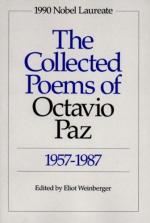|
This section contains 1,322 words (approx. 5 pages at 300 words per page) |

|
Octavio Paz wrote in 1953 his only play, a one-act re-creation of [Hawthorne's] "Rappaccini's Daughter." Re-creation, not simply adaptation. For while the Mexican poet does not tamper much with the plot, he significantly changes the atmosphere and meaning of the tale. Hawthorne contrasts love with "poisonous" sex, transcendent faith with imperfect empirical and rational knowledge. The tone and symbolism of "Rappaccini's Daughter" are influenced by the writings of such intensely moral allegorists as Dante, Spenser and Milton. Paz's chief concern, however, is metaphysical rather than moral; while he treats the human situation as "fallen," his idea of the fall is similar to André Breton's in Nadja: a loss of memory of a deep, original self. Like Breton, and unlike Hawthorne, Paz seeks reintegration, wholeness, through erotic love; but in La hija de Rappaccini, this love is undermined both by its external enemies—a sterile rationalism and a murderous will...
|
This section contains 1,322 words (approx. 5 pages at 300 words per page) |

|


